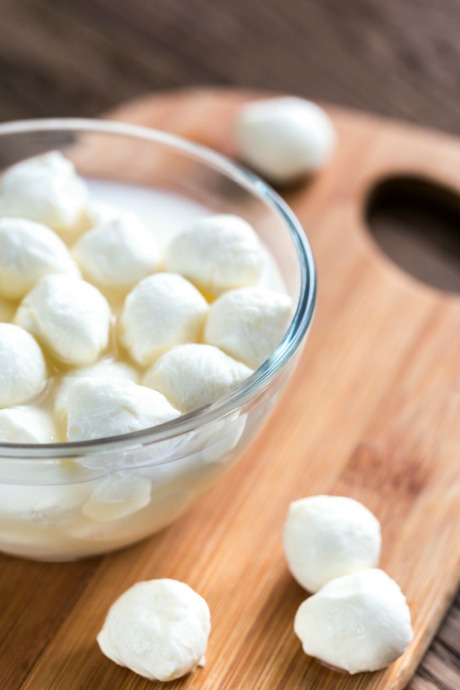Homemade Mozzarella for the Amateur Chef
Posted by April on Sep 17th 2018
While everyone loves eating cheese, the idea of making it sounds complicated. It’s easy to think that making cheese involves lots of milk, specialized equipment, and a cheese cave. But did you know that there are several kinds of cheese the average cook can create in her own kitchen with simple kitchen tools? Cream cheese, cottage cheese, ricotta, and mozzarella are all soft cheeses that don’t require aging or fancy equipment.
Mozzarella is one of the easiest cheeses to make. If you want a fun kitchen project, try making your own mozzarella with this basic recipe.
Homemade Mozzarella: Tools You Need
Most of the kitchen tools you need to make mozzarella are probably already in your cupboards and drawers.
- A stainless steel stockpot, large enough to hold a gallon of milk (four quarts), plus a little extra
- An accurate food thermometer
- A long knife to cut the curds
- A large spoon or ladle to stir the curds
- A colander
- A large microwave-safe bowl
All of your equipment should be scrupulously clean, as should your workspace. Also, don’t try to multitask while making cheese. It’s one of those things that you have to pay attention to while you’re preparing it. Set up all of your equipment and ingredients before you start. Timing is everything with cheesemaking, and you don’t want to be searching for a missing tool while you’re in the middle of making cheese.
Homemade Mozzarella: Ingredients You Need
The ingredient list for mozzarella is surprisingly brief:
- 1 gallon of milk
- 1-1/2 teaspoon of citric acid dissolved in 1 cup of cool water
- 1/4 rennet tablet or 1/4-teaspoon liquid rennet dissolved in 1/4-cup water
- 1 teaspoon salt
Although mozzarella contains only a few ingredients, you may not have citric acid or rennet on hand. Citric acid helps the cheese become stretchier -- a key characteristic of mozzarella. Rennet is an enzyme that helps rearrange the proteins in the liquid milk so that it becomes a solid cheese. It transforms milk into curds and whey, just like the nursery rhyme.
Fortunately, both of these ingredients are easy to obtain. You can find citric acid in the grocery store with the canning supplies. Look for rennet at a health food store or a natural food supermarket. You can also order them online if specialty grocery stores aren't common where you live.
Of course, the key ingredient in homemade mozzarella is milk.

If you don't have your own milk cow who has recently had a calf, you can buy milk at the grocery store. Whole milk is best for cheesemaking; low-fat and skim milk will make a drier, less tasty cheese. Be sure your milk is not ultra-pasteurized; UHT pasteurization alters the proteins in milk, and your cheese will not set up. Organic milk is often ultra-pasteurized, so be sure to read the label carefully.
Finally, don't use iodized table salt in your mozzarella. Kosher salt, pickling salt, or another flaked salt is best.
Homemade Mozzarella: Instructions
Now that you have all your tools and ingredients assembled, it's time to start cooking.
Pour the mixture of citric acid and water mixture into your pot. Add the gallon of cold milk to the pot, and stir to fully combine the ingredients. Over low heat, slowly warm the milk to 90-95F. The milk should begin to curdle (solidify) slightly as the temperature rises.
Remove the pot from the heat, and add the rennet mixture. Stir all the ingredients thoroughly for at least 30 seconds to ensure the rennet is fully incorporated. Cover the pot, and let the mixture rest.
Check the mixture after 5 minutes. The solid curds should be separating from a clear, yellowish whey. If the whey is still cloudy and milky in appearance, wait before proceeding to the next step. It may take up to 30 minutes.

Once the curds have solidified and the whey is clear, use your long knife to cut the curds into a 1-inch checkerboard pattern. Place the pot back on the stove, and heat the curds and whey to 105F while stirring constantly. When the temperature reaches 105F, remove the pot from the heat and stir gently for up to 5 minutes.
Set the colander in the sink, and scoop the curds from the pot into the colander. Press the curds gently with clean hands to remove as much whey as possible.
Place the curds in the bowl and microwave them for one minute. More whey should emerge from the curds; drain them in the colander as you did before, pressing out the excess whey. Microwave the curds twice more in 30-second bursts, pressing out the whey after each time.
After you’ve microwaved the curds for the third time, stretch and knead the cheese on a clean counter top. Sprinkle it with the salt, and press and stretch to knead the salt into the cheese. Keep kneading until the cheese is smooth and shiny. Then shape it into one large ball or several smaller balls.

Your homemade mozzarella is ready when it is cool enough to eat. You can store it in the refrigerator wrapped in plastic wrap for several days, but it is best when eaten fresh. Use it just as you would use commercially-produced cheese. Shred it for pizza, slice it for a sandwich, or just eat it fresh with tomatoes and basil as an appetizer.
As an avid farmer, gardener, and cook, April Freeman is an expert in the food production process. She raises pigs, chickens, beef cattle, and grows a wide variety of vegetables and fruits on her family farm in Tennessee. Learn more about April’s firsthand experience with farm-fresh food on her blog, Feeding My Family.

